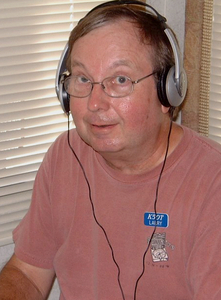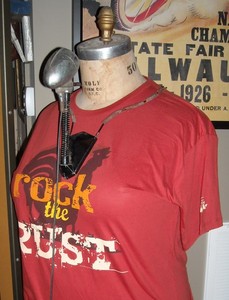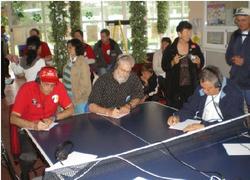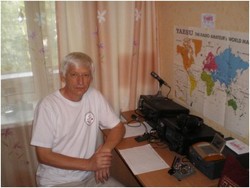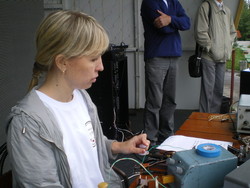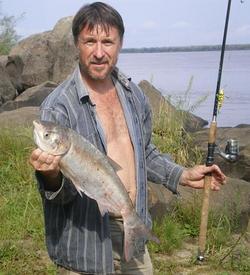 September 14, 2011 Editor: Ward Silver, NØAX | |||||||||
IN THIS ISSUE
NEW HF OPERATORS - THINGS TO DO If you want to try working "over the pole", the Scandinavian Activity Contest is just what you need! The North American Phone Sprint is hectic, especially with the special QSY rule, but a lot of fun and a good workout. BULLETINS There are no bulletins in this issue. BUSTED QSOS The Guam call sign of Dave N2NL is NH2T, not KH2L as reported in the previous issue. You were going to copy that off the air and not use my busted spot, weren't you? Of course! (Thanks, Dan K1TO) CONTEST SUMMARY Complete information for all contests follows the Conversation section Sep 17-18
Sep 24-25
The ARRL Sweepstakes has a new manager, Larry Hammel K5OT! After discovering the Novice Roundup and Sweepstakes in QST, Larry also noticed the exploits of Vic Clark W4KFC. "I wanted to know more, so I wrote him a letter filled with a list of crazy questions about contesting and operating techniques. What followed was magical. Vic actually wrote me back and we traded letters and then contest QSOs during the next few years. I never met this contesting/SS legend in person, but his simple efforts to mentor a young contest enthusiast made an indelible impression on me." An officer of the Central Texas DX and Contest Club, Larry has operated from home and from many contest stations, "...but there is nothing like SS each fall! Sweepstakes has an amazing history and tradition to uphold, and Ken K5KA (SK) and Dan K1TO have each made incomparable contributions to increased SS activity and enjoyment. These are huge shoes to fill, but I welcome the chance." Expect to see more from Larry in this newsletter's upcoming issues. Fans of the "American Pickers" TV show may also be interested in the Antique Technology website and stores in LeClaire, Iowa and Nashville, Tennessee. I got to visit the Nashville store with Kirk K4RO on a recent vacation and found it full of fascinating stuff...but no old radios! My steam-powered radio aficionado readers will surely want to help them include antique wireless in their displays! Oops! PileUp! magazine did it again with a 52-page issue focused on the upcoming Scandinavian Activity Contest and articles like "The Perfect Amplifier". Look for another issue in November. You'll be able to find out who prevailed in the annual "Polar Battle"! (Thanks from the editors, OH1WZ, OH6KZP & OH7WV)
Sad news from the HG6N team - "...at the broadcast site the HG6N crew got from Antenna Hungaria Broadcasting Company...thieves cut off about 1 km of open bronze feed line. The USA/CA branch is fully destroyed." You can see some feed line pieces left behind in the photo. (Thanks, Zoli HA1AG) The April issue of the IEEE Antennas and Propagation Magazine (Vol. 53, No. 2) includes an interesting look at very early wireless technology. The Historical Corner article by Sándor Jeszensky - "From Electric Oscillations to Marconi's Wireless Telegraph" - spans the six decades between Faraday's experiments and Marconi's radio. There are some eye-catching photographs and reproductions of old drawings. How we got from there to here is a fascinating story. The article may be available through professional societies or via your local library's help desk. You've built the amplifier...now what? How about Electric Drag Racing as described in this Design News story? Contest veterans will well remember the call sign of Doc K8RR, originally WA8ZDF then KN8Z, who became a Silent Key on September 12th. As Tom K8AZ recounts, "Doc was a true larger-than-life legend out here in flyover country (the U.S. Midwest - Ed.), and did much to show that contest success from west of the Allegheny mountains COULD be achieved." Web Site of the Week - Maker Faire returns to New York this weekend on September 17 and 18. It will be held at the New York Hall of Science in Queens. The Hall of Science Radio Club will be on hand to demonstrate ham radio (look for the Science Maker entry titled "Build Antennas to Talk Around the World".) There are a number of "mini" Maker Faires coming up in cities around the country - perhaps your radio club could help present ham radio to these motivated makers? WORD TO THE WISE Read the rules BEFORE the contest, runic though they may be! How much off-time and how long are the breaks? Where are the power limits set? Can single-ops use the spotting networks? Don't embarrass yourself by having to back-track after the contest, submitting in a category you didn't know you had entered! Live vicariously through YouTube as Craig K9CT shows us W2GD and K4ZA managing the process of putting his big 40 meter Yagi stack on a 190-foot tower! The RD3A team takes a slightly different approach to putting up their 5-element cannon. We can dream, can't we? (Thanks, Tim K3LR and Randy K5ZD)
Here's one way to stay fit while you're contesting - pedal your way to that special QTH! Take a look as K6BBQ shows us his mobile tricycle station in the recent North American QSO Party. (Thanks, Randy K5ZD) The Orca DX Club's web page is certainly packed full of information for DXers and contesters alike, such as the "Orca Pod" propagation package - nicely packaged and very useful! (Thanks, Bud VA7ST) CQ WW 2010 logs have been processed by Stan EI6DX's Analyser and the results are now available for analysis and preparation for CWWW 2011. Comparing 2010 to 2009: SSB logs were on the rise (6182 vs 5706 in 2009) but CW submissions were down - 5342 vs 5522 in 2009 or 3.25% lower. Despite lower number of logs submitted 2010 CW broke the 70,000 QSOs per hour threshold for the very first time. This is the highest rate observed since logs became public in 2007. The winning hour was 15:00 on the first day when 70.449 QSOs were made. Learn more at the Analyser website! Brian K9QQ has now updated the Society of Midwest Contesters list of Sprint records following last weekend's CW event. This might give your club some ideas about tracking and listing record-holding members to spur interest and recognize good work! OPERATING TIP Arrgh - be prepared for those Maritime Mobile stations on September 19th, me hearties! (Thanks, Gail KB6EZB) Tom W8JI cautions us against tuning up an amplifier at reduced power because the output matching network controls (TUNE and LOAD) won't be set properly when operating at full power. The low-power tuning increases loaded Q in the tank circuit, leading to high voltage and heating. "Even with a 3-kilovolt supply, you can create over 10,000 volts in the tank by peaking (output) power at low drive and then increasing drive. That can put you off the air with capacitor or bandswitch failures." This is illustrated by a low-voltage demonstration on Tom's website. For best performance and the least distortion (splatter) Tom recommends, "adjust at full power and then reduce drive to the legal power. This way the bandwidth before readjustment is required as wide as possible and changes in SWR as antennas are changed does not have a negative impact. It is almost always much easier on the amplifier and other people to over-couple (load at higher power) and then back off." You can read more on Tom's website.
The September issue of "The Black Hole" newsletter of the Society of Midwest Contesters features some photos by Mike W9RE of his big homemade 20 meter Yagis showing building and lifting technique. Learn from a master! Tower climbing pro, Dan K1TO, points out that thrust bearing bolts are not designed to support a heavy mast as described in the previous issue. The way to do this properly is to have at least one muffler clamp with a saddle (or better yet, two saddles with through bolts) tightened securely to prevent any downward slippage of the mast while moving the rope attachment point. When installing antennas on a mast, don't forget to leave a "rotator loop" in the feed lines to allow the antennas to turn without pulling on the cables! As Steve K7LXC points out, "There are two rotator loop methods. One has the cable(s) coming off the mast with 5-6 extra feet to just hang off the tower and follows the mast around as it turns. The other way is to loop the cable(s) 2-3 times around the bottom of the mast at the flat top of the tower 2-3 times. The cables sit on the tower top and allow lots of rotation. Either way works Fine Business." New digital scopes have some excellent features previously too expensive for ham gear, such as the Fast Fourier Transform (FFT). If you would like to learn more about how this feature works, EE Times magazine sponsored a webinar on "FFT and frequency analysis using an oscilloscope" presented by Rohde and Schwartz. Many other technical topics are represented in the list of available programs. Hans, PA1HR has compiled a very nice table of measurements showing a comprehensive view of many transceivers evaluated in ARRL Product Reviews. Maybe this will help you win a few arguments at the meeting-after-the-meeting when the talk turns to rig performance! (Thanks, Glenn K6NA) I wonder if Gem Quad knows about the new kind of wire that is spun from sapphire crystals? It is supposedly of much higher conductivity than plain, old copper but might be hard to solder! Bob K4HJF has a great idea to save builders some significant scratch - he uses surplus test equipment chassis for his projects. These beautiful and sturdy cabinets are made with top-quality hardware and are easily "repurposed" for ham projects, such as his new 2 meter amplifier. You'll see many obsolete pieces of gear selling for "get it out of here" prices at hamfests, so take one home and salvage the many useful components, leaving yourself a nice looking enclosure. Radioshack has announced "The Great Create" - a contest to come up with the most interesting creations made using Radio Shack parts. I'm sure the readers of this newsletter can come up with some thought-provoking (good or bad) entries! Popular Mechanics' "PM Saturday" column describes a one-afternoon project just right for non-contest weekends. The October 2011 issue's project is a T-shirt cannon made from PVC pipe and an irrigation valve. I don't know about you, but when I see "t-shirt cannon", I think "antenna in tree"...I'm just sayin'. Technical Web Site of the Week - Admit it! When the contractor shows up to dig the hole for a tower base or whatever, don't you wish you were in the seat of that machine, working the levers and moving that dirt? Don't sigh so deeply! Next time you are in Las Vegas, stop by Dig This and spend a little time with their toys pushing the desert around to your heart's content! Another Good Idea - Friendship Radiosport Games Tree N6TR recently visited UAØC (Khabarovsk) as an official in the very-WRTC-like radiosport games he describes below. He graciously agreed to write a short article describing the events and I'm sure you will find it and the pictures interesting. At a time when meetings and hamfests are responding to challenges of attendance, it is good to read of an event doing well and attracting visitors from around the world! 73, Ward NØAX
The Tenth Friendship Radiosport Games were held last month in Khabarovsk, Russia. These games started up in 1989 as a result of a sister city agreement between Khabarovsk and Portland, Oregon. Over the years, participation has grown to include other sister cities in the Pacific Rim including Victoria, British Columbia; Niigata, Japan; Harbin, China; Bucheon, South Korea; and Melbourne, Australia. The games themselves have been held in Russia, Japan, Canada, and the United States.
The "father" of the games is Yvegeny "Eugene" Stavitksy, UAØCA. It was his vision that enabled the first games to take plan in Russia during the Cold War in 1989. The events held during the games include Morse code copying and sending tests, a Morse code pileup test, foxhunt and on-air competition. In addition to these events, several excursions take place, enabling participants to get a flavor of the area they are visiting. Most of the people travelling from foreign countries are put up in the homes of the hosting hams. The Morse code copying and sending tests use code groups so as not to give an advantage to native speakers of any language. The sending test uses a unique method to assure that skills are distributed amongst the use of a hand-key, bug and electronic keyer. There are five code groups that must be sent with a hand-key, followed by ten code groups that can be sent with either a hand-key or a bug. Finally, there are ten more code groups that can be sent using any method including an electronic keyer. The final score is the total time that it takes to send the three groups with a penalty of ten seconds for each uncorrected error. The winner of this event, Alexander Savin UAØCDX, only used the hand-key to send all of the groups. He combined an error free performance with a steady rhythm to send his three segments in just 83 seconds.
The receiving test consists of seven code groups starting at 10 WPM and increments by 2 WPM up to 60 WPM. Participants must copy at least five of the seven groups correctly to qualify for a given speed. The typical winning score at these events has been around 34 WPM. Following the receiving test, a pile-up tape is played and the scores are how many correct call-signs were copied. The winner of the code copying contest this time was Oleg Danko, UAØCO. Alex Turkin, RWØCR won the pile-up contest with 70 calls. A special "Iron Man" award is given to the person who has the highest combined score from the three events. Each event awards 100 points to the winner. The other people get a weighted number of points based upon how well they did compared to the winner. This year's Iron Man was Oleg Danko, UAØCO.
The HF Contest was an all-day event. There were six teams competing and each operated from the same six stations for about 45 minutes each. The logistics to get the teams shuttled around to different locations were complicated - but pulled off without a hitch. Special call signs were used - with the prefix RG20. This helped generate some nice pileups on the bands with one competitor even working "up 1". A multiplier of X2 was given to CW QSOs, and the USA team stuck to CW to generate the number one score and take the Gold Medal in this event. This event was a great way to make some new friends and better understand the culture of a faraway place. It once again shows how ham radio can help bring the world together and create a better place for us to live. 14 September through 27 September An expanded, downloadable version of QST's Contest Corral in PDF format is available. Check the sponsor's Web site for information on operating time restrictions and other instructions. HF CONTESTS CWops Monthly Mini-CWT Test--CW, from Sep 14, 1300Z to Sep 15, 0400Z, see website, multiple operating periods, twice monthly on 2nd and 4th Wed. Bands (MHz): 3.5-14. Frequencies: 18 to 28 kHz above band edge. Exchange: Name and member number or S/P/C. Logs due: 2 days. Rules Connecticut QSO Party--Phone, CW, Digital, from Sep 17, 0000Z to Sep 17, 2359Z. Bands (MHz): 3.5-28. Frequencies: See website. Exchange: RS(T) and CT county or S/P/C. Logs due: 30 days. Rules CIS DX PSK Contest--Digital, from Sep 17, 1200Z to Sep 18, 1200Z. Bands (MHz): 1.8-28. Exchange: RST and DXDA code. Logs due: 15 days. Rules Scandinavian Activity Contest--CW, from Sep 17, 1200Z to Sep 18, 1200Z. Bands (MHz): 3.5-28. Exchange: RST and serial. Logs due: Oct 2. Rules South Carolina QSO Party--Phone, CW, Digital, from Sep 17, 1300Z to Sep 18, 2100Z. Bands (MHz): 3.5-28, 50+, Frequencies: CW--1.805, 50 kHz above band edge; Phone--1.845, 3.86, 7.261, 14.27, 21.37, 28.37. Exchange: RS(T) and county or S/P/C. Logs due: Oct 20. Rules Feld-Hell Hell on Wheels Sprint--Digital, from Sep 17, 1600Z to Sep 17, 1800Z. Bands (MHz): 1.8-28. Monthly on 3rd Saturday. Exchange: RST, S/P/C, Feld-Hell member nr. Logs due: 7 days. Rules Washington State Salmon Run--Phone, CW, Digital, from Sep 17, 1600Z to Sep 18, 2400Z. Bands (MHz): 1.8-28, 50, Frequencies: See website. Exchange: RS(T) and county or S/P/C. Logs due: Oct 18. Rules North American Sprint--Phone, from Sep 18, 0000Z to Sep 18, 0400Z. Bands (MHz): 3.5-14. Exchange: Call signs, serial, name, and state. Logs due: 7 days. Rules Classic Exchange-- Phone, from Sep 18, 1300Z to Sep 19, 0700Z. Bands (MHz): 1.8-28, 50,144, Frequencies: SSB--1.885, 3.87, 7.28, 14.27, 21.37, 28.39; AM--1.89, 3.88, 7.16, 7.29, 14.286, 21.42, 29.0. Exchange: Name, RS, S/P/C, type of equipment. Logs due: 60 days. Rules BARTG Sprint 75--Digital, from Sep 18, 1700Z to Sep 18, 2100Z. Bands (MHz): 3.5-28. Exchange: Serial. Logs due: Nov 1. Rules Run For the Bacon--CW, from Sep 19, 0100Z to Sep 19, 0300Z. Bands (MHz): 1.8-28. Monthly on 3rd Sunday night (local). Exchange: RST, S/P/C, Flying Pig nr or power. Rules NAQCC Monthly QRP Sprint--CW, from Sep 22, 0030Z to Sep 22, 0230Z. Bands (MHz): 3.5-14. Monthly on 2nd Tuesday or 3rd Wednesday local time (alternating). Exchange: RST, S/P/C, and NAQCC mbr nr or power. Logs due: 4 days. Rules CQ WW RTTY Contest--Digital, from Sep 24, 0000Z to Sep 25, 2400Z. Bands (MHz): 3.5-28. Exchange: RST, CQ zone and State/VE area (US/VE). Logs due: Nov 1. Rules Texas QSO Party--Phone, CW, Digital, from Sep 24, 1400Z, multiple operating periods, see website. Bands (MHz): 1.8-28, 50,144, Frequencies: CW--20 to 50 kHz above band edge; Phone--25 kHz above edge of General segment. Exchange: RS(T), county or S/P/C. Logs due: Oct 31. Rules Fall QRP Homebrewer Sprint--CW, from Sep 27, 0000Z to Sep 27, 0400Z. Bands (MHz): 3.5-28. Exchange: RST, S/P/C, and power. Logs due: 30 days. Rules VHF+ CONTESTS ARRL 10 GHz Cumulative Contest--Phone, CW, Digital, from Sep 17, 6 AM to Sep 18, 12 Midnight. Bands (MHz): 10G+. Exchange: 6-character grid locator. Logs due: Oct 19. Rules ARRL EME Contest--Phone, CW, Digital, from Sep 24, 0000Z to Sep 25, 2400Z. Bands (MHz): 2.3G+. Exchange: Call signs, sig rpt, acknowledgement. Logs due: Dec 20. Rules South Carolina QSO Party--Phone, CW, Digital, from Sep 17, 1300Z to Sep 18, 2100Z. Bands (MHz): 3.5-28, 50+, Frequencies: CW--1.805, 50 kHz above band edge; Phone--1.845, 3.86, 7.261, 14.27, 21.37, 28.37. Exchange: RS(T) and county or S/P/C. Logs due: Oct 20. Rules Washington State Salmon Run--Phone, CW, Digital, from Sep 17, 1600Z to Sep 18, 2400Z. Bands (MHz): 1.8-28, 50, Frequencies: See website. Exchange: RS(T) and county or S/P/C. Logs due: Oct 18. Rules Classic Exchange-- Phone, from Sep 18, 1300Z to Sep 19, 0700Z. Bands (MHz): 1.8-28, 50,144, Frequencies: SSB--1.885, 3.87, 7.28, 14.27, 21.37, 28.39; AM--1.89, 3.88, 7.16, 7.29, 14.286, 21.42, 29.0. Exchange: Name, RS, S/P/C, type of equipment. Logs due: 60 days. Rules Fall VHF Sprint--Phone, CW, Digital, from Sep 19, 7 PM to Sep 19, 11 PM. Bands (MHz): 144. Exchange: 4-character grid square. Logs due: 4 weeks. Rules Texas QSO Party--Phone, CW, Digital, from Sep 24, 1400Z, multiple operating periods, see website. Bands (MHz): 1.8-28, 50,144, Frequencies: CW--20 to 50 kHz above band edge; Phone--25 kHz above edge of General segment. Exchange: RS(T), county or S/P/C. Logs due: Oct 31. Rules Fall VHF Sprint--Phone, CW, Digital, from Sep 27, 7 PM to Sep 27, 11 PM. Bands (MHz): 222. Exchange: 4-character grid square. Logs due: 4 weeks. Rules LOG DUE DATES 14 September through 27 September September 15 - MMMonVHF/DUBUS 144 MHz Meteorscatter Sprint Contest September 15 - Brazil Independence Day BPSK31 CDX Contest September 15 - NAQCC-EU Monthly Sprint September 16 - SKCC Weekend Sprint September 17 - North American Sprint, CW September 19 - DARC 10-Meter Digital Contest September 20 - RSGB SSB Field Day September 21 - Keyman's Club of Japan Contest September 25 - Kulikovo Polye Contest September 26 - Ohio QSO Party September 27 - YO DX HF Contest ARRL Information Click here to advertise in this newsletter. Your One-Stop Resource for Amateur Radio News and Information ARRL membership includes QST, Amateur Radio's most popular and informative journal, delivered to your mailbox each month. Subscribe to NCJ - the National Contest Journal. Published bimonthly, features articles by top contesters, letters, hints, statistics, scores, NA Sprint and QSO Parties. Subscribe to QEX - A Forum for Communications Experimenters. Published bimonthly, features technical articles, construction projects, columns and other items of interest to radio amateurs and communications professionals. Free of charge to ARRL members: Subscribe to The ARRL Letter (weekly digest of news and information), the ARES E-Letter (monthly public service and emergency communications news), Division and Section news -- and much more! ARRL offers a wide array of products to enhance your enjoyment of Amateur Radio. Visit the site often for new publications, specials and sales. Donate to the fund of your choice -- support programs not funded by member dues! ACKNOWLEDGEMENTS ARRL Contest Update wishes to acknowledge information from WA7BNM's Contest Calendar and SM3CER's Contest Calendar. | |||||||||
